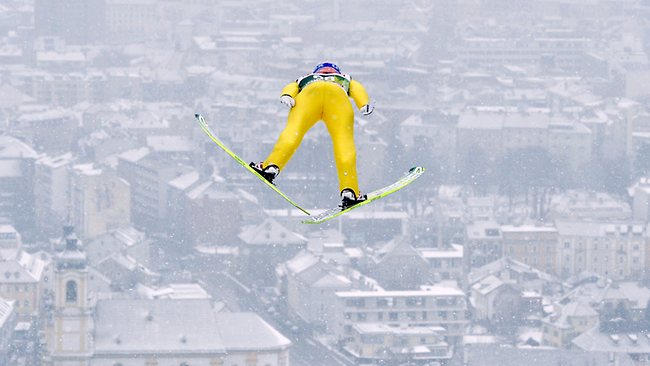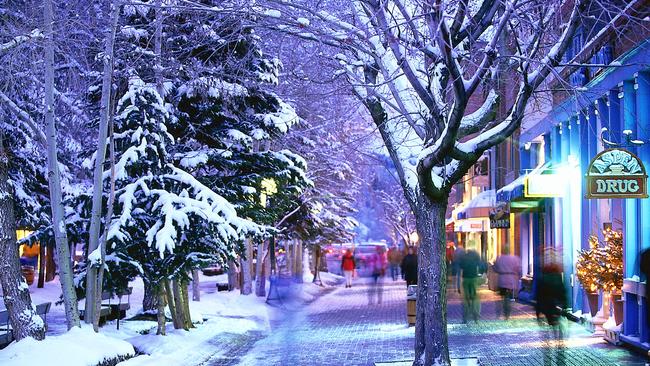Pleasure at Innsbrucker, heart of the European Alps
AUSTRIA is home to the jaw-dropping town of Innsbruck, an urban/alpine mix unlike anywhere in Europe with some of the world's best skiing.

"ICH bin ein Innsbrucker!"
A little tricky to say at first, but after just a few days in this jewel of the European Alps it rolls off the lips. Stay a while and you'll likely warm to this elegant city and its people to a point you may feel, even fleetingly, like a local. An Innsbrucker.
Austria is the geographic centre of Europe, and Innsbruck is the heart of the Alps. First-time visitors can be forgiven if their jaws drop at the sheer beauty of the place.
The capital of the Tyrol region is cradled between two huge mountain ranges seemingly close enough to touch a downtown cable car hoists you to the Nordkette (north) range more than 2km high in just 20 minutes, so office workers can ski in their winter lunch breaks and hike or mountain bike after work in summer.
It is an accessible urban/alpine mix unlike anywhere else in Europe.
Some say the mountains call you. They certainly have a mesmerising presence. And Innsbruckers heed the call. They are an outdoorsy type who ski, hike, bike and generally enjoy life.
Some even yodel.
For Austrians, the mountains are as natural a playground as the beach is for Australians.
The city of 130,000 nestling in the Inn Valley between the mountains, and along the Inn River is well-known as a winter playground. It has hosted two Winter Olympics, in 1964 and 1976.
Nine ski resorts are within easy reach, with 300km of runs. A special ski pass gives access to them all and free shuttle buses run regularly.
Perhaps less well known is the pleasure of exploring the city in warmer months. The buildings are dressed with window boxes of flowers bursting with colour; pushbikes are everywhere; and people are out and about enjoying days that get so hot it is hard to believe the nearby mountains have snow on their peaks.
People hike and bike the surrounding mountains, with guides such as Wolfgang Platzer able to show the beauty of the area, including the abundant wildflowers.
After a 3.4km cable-car ride up the 2250m mountain Patscherkofel, Platzer took us on a brisk hike around spectacular forested mountain trails with sweeping views over the city and across to the parallel Alps on the other side. The morning's walk led us to a mountain hut positioned among 400-year-old pine trees; a wooden mini-chalet, its walls covered with animal skins; musical instruments; guns; climbing gear; and other Tyrolean treasures.
Huts dot the mountains where hosts offer meals and drinks for passers-by you can also bunk overnight. This hut, the Almgasthaus Boscheben, had dormitory rooms and a more private "honeymoon" room.
During summer, anyone staying overnight in a hotel in the Innsbruck region can join a free program of guided hikes.
If you like your sport a little more extreme, Innsbruck can accommodate. In summer, take a spin down the Olympic bobsleigh track in a four-man bobsleigh. Remember the movie Cool Runnings? Fortunately our missile was piloted by an expert driver and was on wheels rather than on winter ice. Once squashed in and flying around banked walls on the downhill run, we hit 100km/h while covering the 1.2km purpose-built track.
The Olympic giant ski jump towers above the city. You need to have about 2000 jumps under your belt before tackling this monster, but visitors can stand on a restaurant veranda a few metres directly above the start point of the jump, look down at the plunging track and imagine.
Within four seconds skiers reach about 90km/h while hurtling down the 98m track, then must time their take-off to perfection to sail some 140m, then hopefully land with style. Not for the fainthearted.
Other extreme diversions include a ride on a flying fox, where your harness is hooked to an overhead cable and you go running off a cliff, then "fly" 100m, dangling from the wire.
Those seeking less excitement may prefer exploring Innsbruck's history as a key centre of the Austrian Empire during about 600 years of Hapsburg rule. The grand legacy of this imperial era are palaces and cathedrals reeking of power and wealth.
The four-storey Hofburg Palace has about 400 rooms spread over 5000sq m. Its public rooms house huge portraits, gilt chandeliers, ornate ceilings and fixtures. The Giants Hall, a vast ceremonial chamber with massive portraits and splendid painted ceiling, whispers of the majesty of the past.
Nearby, the Hofkirche, or Court Church, houses the huge tomb of Emperor Maximillian I, ringed by 28 larger-than-life bronze statues of his ancestors and heroes of antiquity.
Largely a low-rise city, areas such as the Old Town have brightly coloured three and four-storey buildings in rows, many with ornate paintings on their exteriors. One famous building even has a roof of gilded copper tiles. It was built by Archduke Friedrich IV so Emperor Maximilian I could watch daily life in the cobblestone square below in suitable glory.
Take a stroll along the lane from this golden landmark towards St James Cathedral and stop at Culinarium, a tiny shop packed with gourmet goods, where jovial host Herby Signor has footpath tables for visitors to sample items such as champagne with gold leaf, cheeses, pates, produce and schnapps.
For a tasting of the Rolls-Royce of schnapps and a lesson on how the real thing is so different from the strong, sweet liquid many Australians associate with schnapps, head for the Rochelt distillery. They make schnapps from 18 different types of fruit, age it in glass balloons for up to a decade and let natural fermentation do its work.
The city may be regal but it is also funky. For a mix, stroll Maria Theresien Strasse, then head for the Kaufhaus Tyrol shopping centre and the Rathaus Galerien mall with its trendy Lichtblick wine bar and restaurant.
While Innsbruck is Queen of the Alps, don't forget its equally charming attendants. About 25 villages are dotted in the mountains rising around the city, as close as 15 minutes away.
Villages such as Lans, Aldrans, Sistrans and Wattens carry their own charm, but for me Igls was an absolute gem, with its quaint old buildings, including traditional farmhouses with large wood verandas, a fine church, magnificent views and a tram running 8km to the city.
While wandering Igls on a Sunday, we stumbled across a major festival, with residents dressed in traditional Tyrolean costume, bands playing, and ceremonies, including the firing of cannons. A row of young Tyrolean men raised rifles to their shoulders and, on command, fired into the air; then it was off to the local park for a picnic with steins and singing.
The writer was a guest of the Austrian National Tourist Office![]() Travel Tips: Austria destination guide
Travel Tips: Austria destination guide![]() Holiday Ideas: Ski tips 2011
Holiday Ideas: Ski tips 2011



